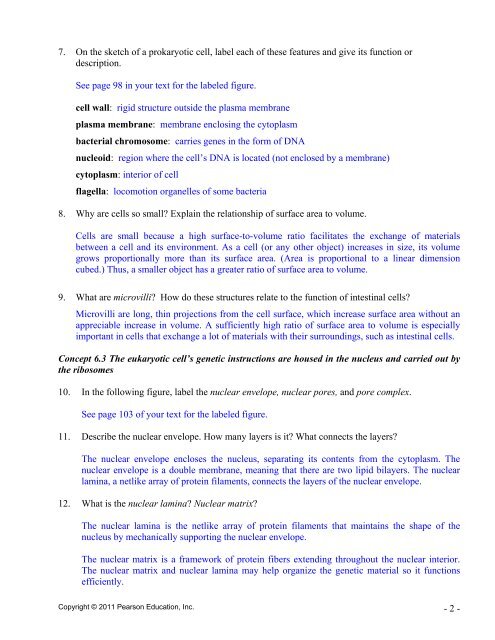You also want an ePaper? Increase the reach of your titles
YUMPU automatically turns print PDFs into web optimized ePapers that Google loves.
7. On the sketch of a prokaryotic cell, label each of these features and give its function or<br />
description.<br />
See page 98 in your text for the labeled figure.<br />
cell wall: rigid structure outside the plasma membrane<br />
plasma membrane: membrane enclosing the cytoplasm<br />
bacterial chromosome: carries genes in the form of DNA<br />
nucleoid: region where the cell’s DNA is located (not enclosed by a membrane)<br />
cytoplasm: interior of cell<br />
flagella: locomotion organelles of some bacteria<br />
8. Why are cells so small? Explain the relationship of surface area to volume.<br />
Cells are small because a high surface-to-volume ratio facilitates the exchange of materials<br />
between a cell and its environment. As a cell (or any other object) increases in size, its volume<br />
grows proportionally more than its surface area. (Area is proportional to a linear dimension<br />
cubed.) Thus, a smaller object has a greater ratio of surface area to volume.<br />
9. What are microvilli? How do these structures relate to the function of intestinal cells?<br />
Microvilli are long, thin projections from the cell surface, which increase surface area without an<br />
appreciable increase in volume. A sufficiently high ratio of surface area to volume is especially<br />
important in cells that exchange a lot of materials with their surroundings, such as intestinal cells.<br />
Concept 6.3 The eukaryotic cell’s genetic instructions are housed in the nucleus and carried out by<br />
the ribosomes<br />
10. In the following figure, label the nuclear envelope, nuclear pores, and pore complex.<br />
See page 103 of your text for the labeled figure.<br />
11. Describe the nuclear envelope. How many layers is it? What connects the layers?<br />
The nuclear envelope encloses the nucleus, separating its contents from the cytoplasm. The<br />
nuclear envelope is a double membrane, meaning that there are two lipid bilayers. The nuclear<br />
lamina, a netlike array of protein filaments, connects the layers of the nuclear envelope.<br />
12. What is the nuclear lamina? Nuclear matrix?<br />
The nuclear lamina is the netlike array of protein filaments that maintains the shape of the<br />
nucleus by mechanically supporting the nuclear envelope.<br />
The nuclear matrix is a framework of protein fibers extending throughout the nuclear interior.<br />
The nuclear matrix and nuclear lamina may help organize the genetic material so it functions<br />
efficiently.<br />
Copyright © 2011 Pearson Education, Inc. - 2 -


